Master 10 Top Negative Prompts: Examples and Develop Guide
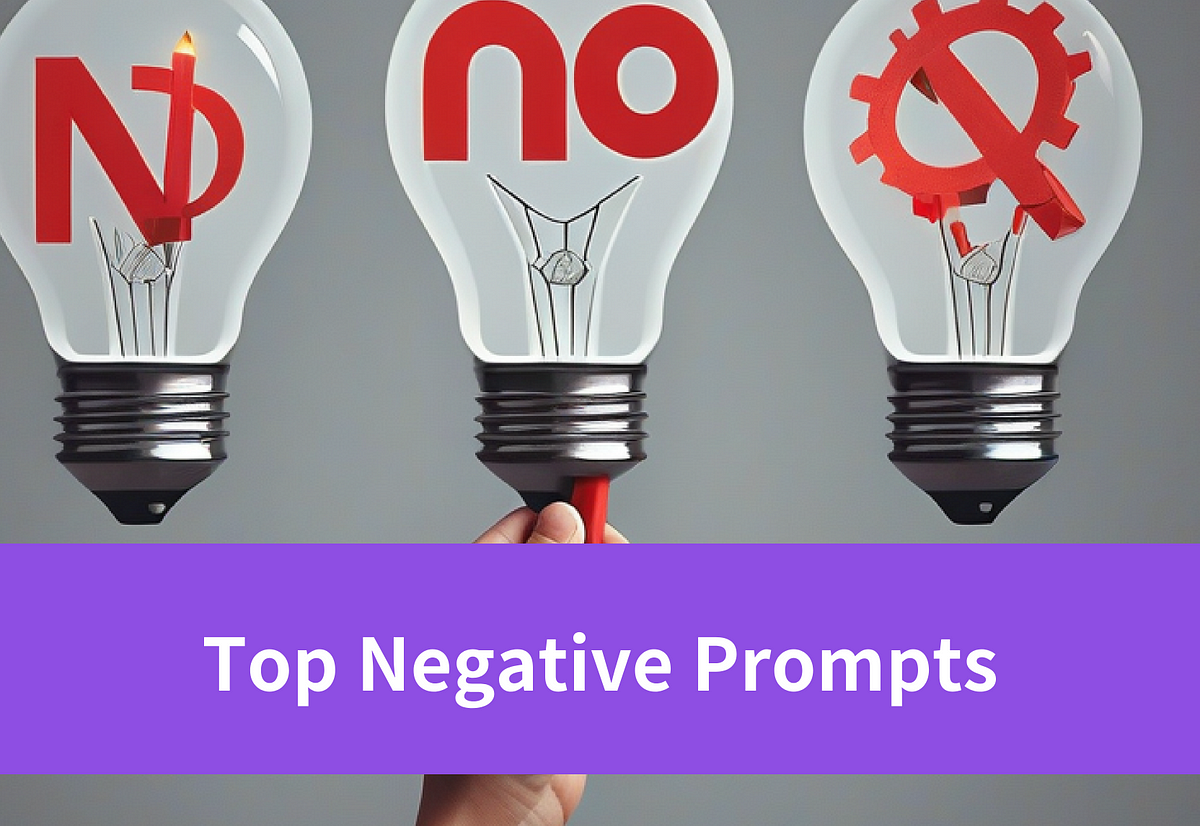
Explore top negative prompts with our comprehensive guide. Enhance your understanding and skills with practical examples.
Key Highlights
- Definition of Negative Prompts: Negative prompts guide AI models by specifying what should be excluded from the output, helping to improve content quality and relevance.
- How They Work in Stable Diffusion: They help by removing unwanted elements or styles. They are used alongside positive prompts to achieve desired results.
- LLM Relation: Large Language Models (LLMs) help generate negative prompts to avoid making sensitive or unwanted content, enhancing control in text and image generation.
- Top Negative Prompts: Common negative prompts include avoiding poorly drawn features, unwanted elements, and unrealistic body proportions. For text, they help reduce repetition and limit length.
- Application and Customization: Negative prompts can be tailored for various creative needs and industries, including digital art, content creation, and AI projects.
- Developing a Negative Prompt Tool: Steps include defining objectives, selecting models, designing user interfaces, integrating LLMs, and optimizing performance.
Introduction
Negative prompts are powerful tools in AI image and text generation, allowing users to exclude unwanted features and enhance the quality of their output. By specifying what to avoid, they provide greater control over the creative process, making them invaluable for artists, content creators, and developers. This guide explores how negative prompts work, their applications, and how to develop a tool for better AI content generation using platforms like Novita AI.
Understanding Negative Prompts
Negative prompts guide AI generation models like Stable Diffusion by specifying what to exclude from an image, offering users greater creative control. By identifying common mistakes like poor anatomy, low resolution, or unwanted details in negative prompts, you can enhance the quality and relevance of the artwork.
What is a Negative Prompt
A negative prompt filters unwanted features during AI image creation, improving image quality and reducing errors. It guides the AI toward a specific style or look, ensuring the image aligns with the artistic vision. This precision enhances creative work and yields superior results compared to traditional editing methods.
How Does Negative Prompt Work in Stable Diffusion
During the stable diffusion image generation process, the AI model looks at both the positive and negative prompts from the user. The positive prompt helps show what the user wants, including the main subject and how it should look. The negative prompt removes objects or styles in a unique way that can’t be achieved by adjusting a positive prompt alone. It hijacks the unconditional sampling in each step, guiding away from the negative prompt’s description.
To see the effect, you can use the following prompts on Novita AI Image Playground.
- Positive prompt: Portrait photo of a man.
- Negative prompt: Mustache
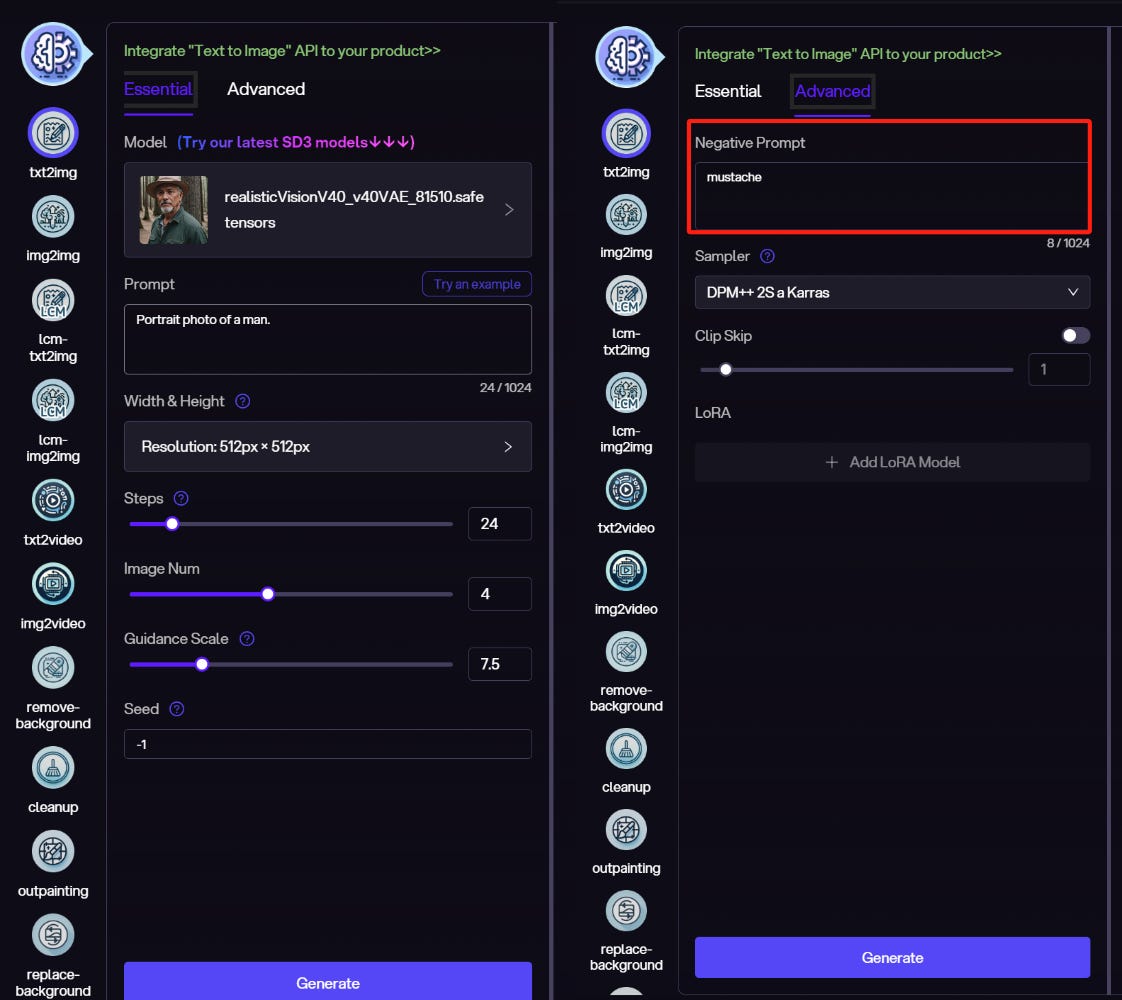
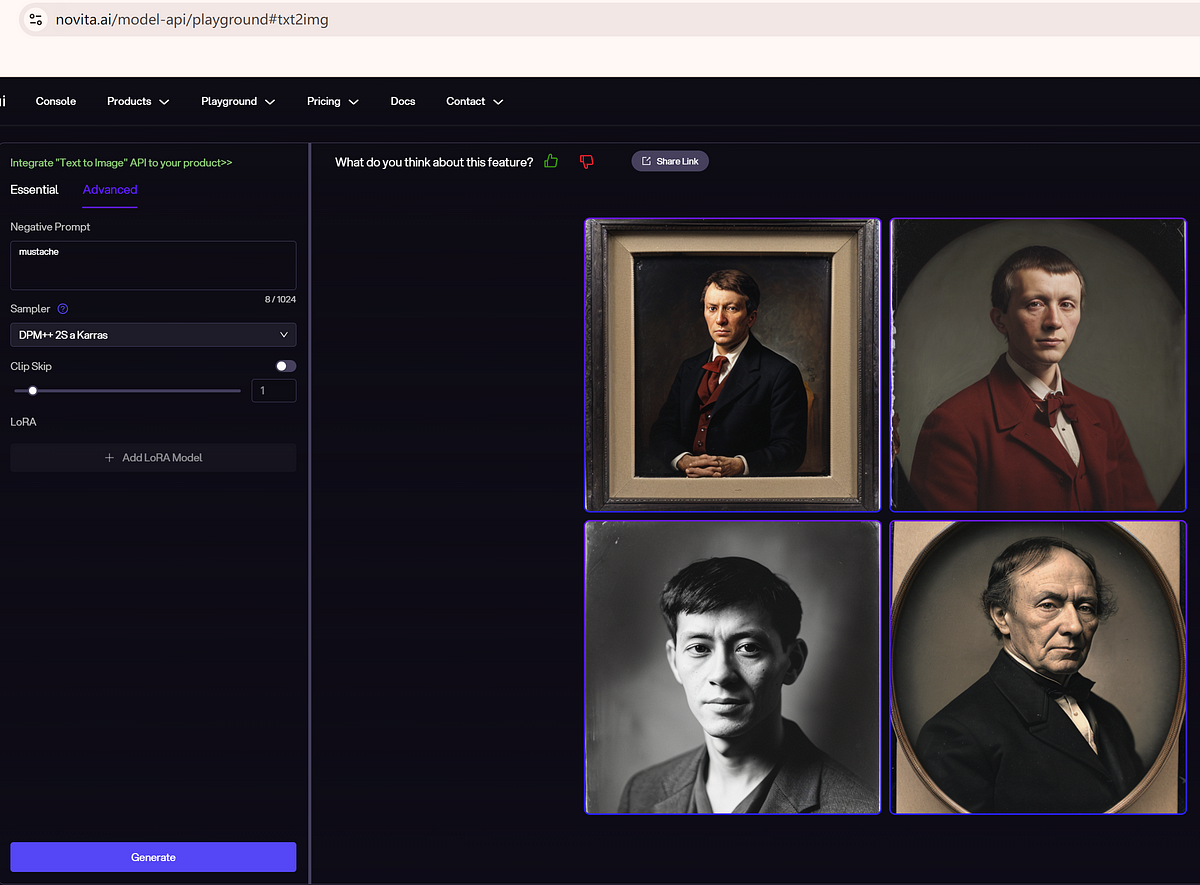
How does LLM Relate to Negative Prompts
Large Language Models (LLMs) rely on extensive text and code datasets to interpret human language effectively, and they can be used for stable diffusion. Negative prompts guide these models by indicating what should be excluded from generated images, preventing sensitive or unwanted content. In roleplaying games, dynamic updates to negative prompts steer character interactions away from certain topics or behaviors, showcasing how LLMs merge human creativity with AI image generation through natural language processing and advanced machine learning.
To know more info, you can join the discussion about Negative Prompts on Reddit.
Exploring 10 Top Negative Prompts: A Comprehensive Guide
For Stable Diffusion Images
1. Anime/Character Facial Features
- Prompt: “poorly drawn face, fused face, cloned face, extra eyes, oversized eyes”
2. Color Palette
- Prompt: “color cast, washed out, unnatural glow, harsh shadows”
3. Lighting Problems
- Prompt: “bad lighting, uneven light, overexposed, underexposed”
4. Unwanted Elements
- Prompt: “text, watermark, logo, signature, username, jpeg artefacts, compression artefacts, pixelation, blur, extra limbs, extra digits, misplaced objects, unwanted background, mutated anatomy, monochrome, horror, geometry, disgusting, mutated, cartoonish, unnatural, fake reflections, digital glitches, nsfw”
5. Bad Proportions
- Prompt: “No extra crus, no fused crus, not extra thigh, no fused thigh”
6. Inconsistent Style
- Prompt: “ mixed styles, uncoordinated colors, disjointed art style, unmatched brushstrokes”
7. Basic Image Quality
- Prompt: “worst quality, low quality, blurry, low res”
8. Unrealistic Body
- Prompt: “Extra fingers, missing legs, missing arms, extra legs, long neck”
For Text Content
1. Reduce Repetition
Prompt: “Please refrain from restating previously mentioned points.”
2. Limit Length
Prompt: “Please avoid lengthy explanations” or “Try to answer in one sentence if possible.”
Tips for Implementing Top Negative Prompts
Using negative prompts in AI image generation requires a clear plan. Decide what to remove or reduce in the final image, and convert these choices into keywords for the AI model to understand. Experiment with wording to optimize results.
Identifying the Right Context for Each Negative Prompt
For example, when creating a realistic portrait, negative prompts like “cartoonish features” or “exaggerated proportions” work well. Experimenting with prompts is crucial to understanding their impact on the final image. Consider how each prompt complements your art style and subject matter before using it.
Customizing Negative Prompts for Diverse Creative Needs
Users can start with common prompts and adapt them to create unique results. For example, focusing on a theme or style allows users to identify possible mistakes in that area, aiding in improvement and artistic expression. This customization empowers users to shape their AI-generated art intentionally.
Real-World Applications and Cases Using Top Negative Prompts
AI technology is changing creative industries with negative prompts. Artists and designers use negative prompts to enhance digital art, adding detail and gaining control. This impact is evident in the success stories of artists creating precise AI-generated art that blends reality and imagination in innovative ways.
AI Artists
Digital artists who use tools like Stable Diffusion, DALL-E, or MidJourney often employ negative prompts to fine-tune their generated images. For example, an artist might use a negative prompt to avoid certain colors or styles that don’t fit their desired aesthetic.
Here is a YouTube video about how negative prompts shaped their artistic journey.
Content Creators
Those who create visual content for blogs, social media, or marketing can use negative prompts to ensure their generated images align with their brand. For example, a marketer might use a negative prompt to exclude certain backgrounds or themes that don’t match their campaign.
Developers in AI Projects
Developers working on AI-based creative projects can use negative prompts as part of their workflow to guide models towards generating more desirable outputs. This might be part of developing a custom image generation tool or a game.
Researchers and Academics
In academic settings, researchers studying AI-generated art or language models can use negative prompts to study how AI interprets exclusions or how to control model outputs better like in this research paper.
How to Develop Your Negative Prompt Tool: Improving Content Quality
Developing a Negative Prompt Tool can significantly enhance the quality and precision of AI-generated content, whether for images or text. By allowing users to specify what they don’t want in the output, this tool helps create more refined and targeted results. If you’re building such a tool and looking for a powerful platform to support your AI needs, consider using Novita AI. With its robust infrastructure and advanced LLM capabilities, Novita AI provides everything you need to develop, test, and deploy your tool efficiently.
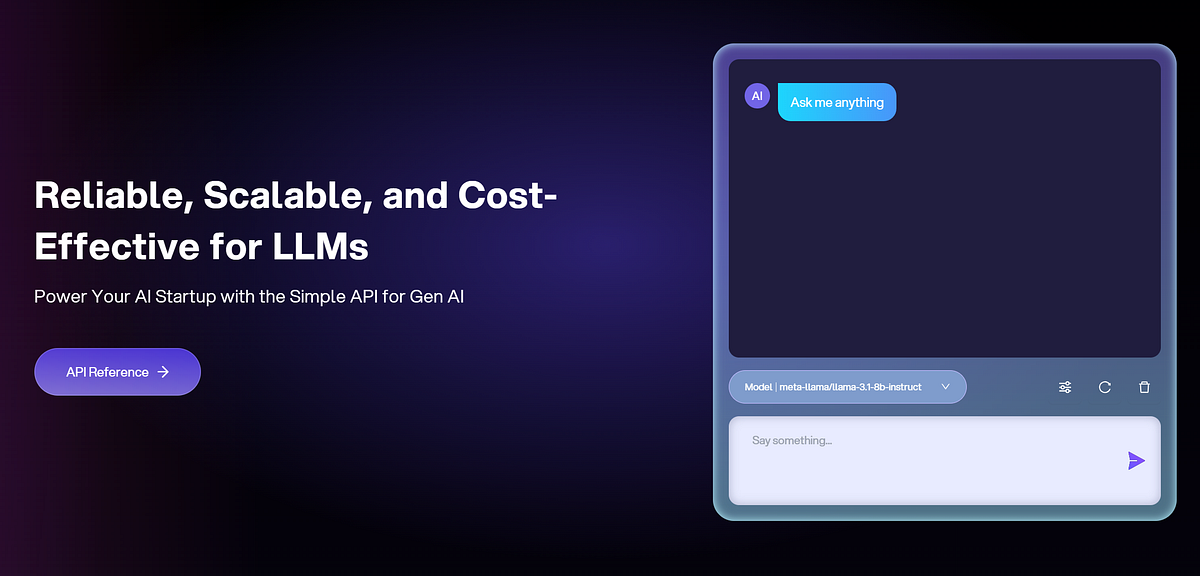
Step-by-Step Guide: Efficient Approach
Step 1. Define the Objective: Establish the purpose of the negative prompt tool, such as refining AI-generated images or text by excluding specific elements.
Step 2. Select a Model: Choose a suitable large language model (e.g. Llama 3.1 405B and Gemma-2–9b-it) for a text-based generation.
Here is the generated content using Gemma-2–9b-it. You can test various models on Novita AI LLM Playground.
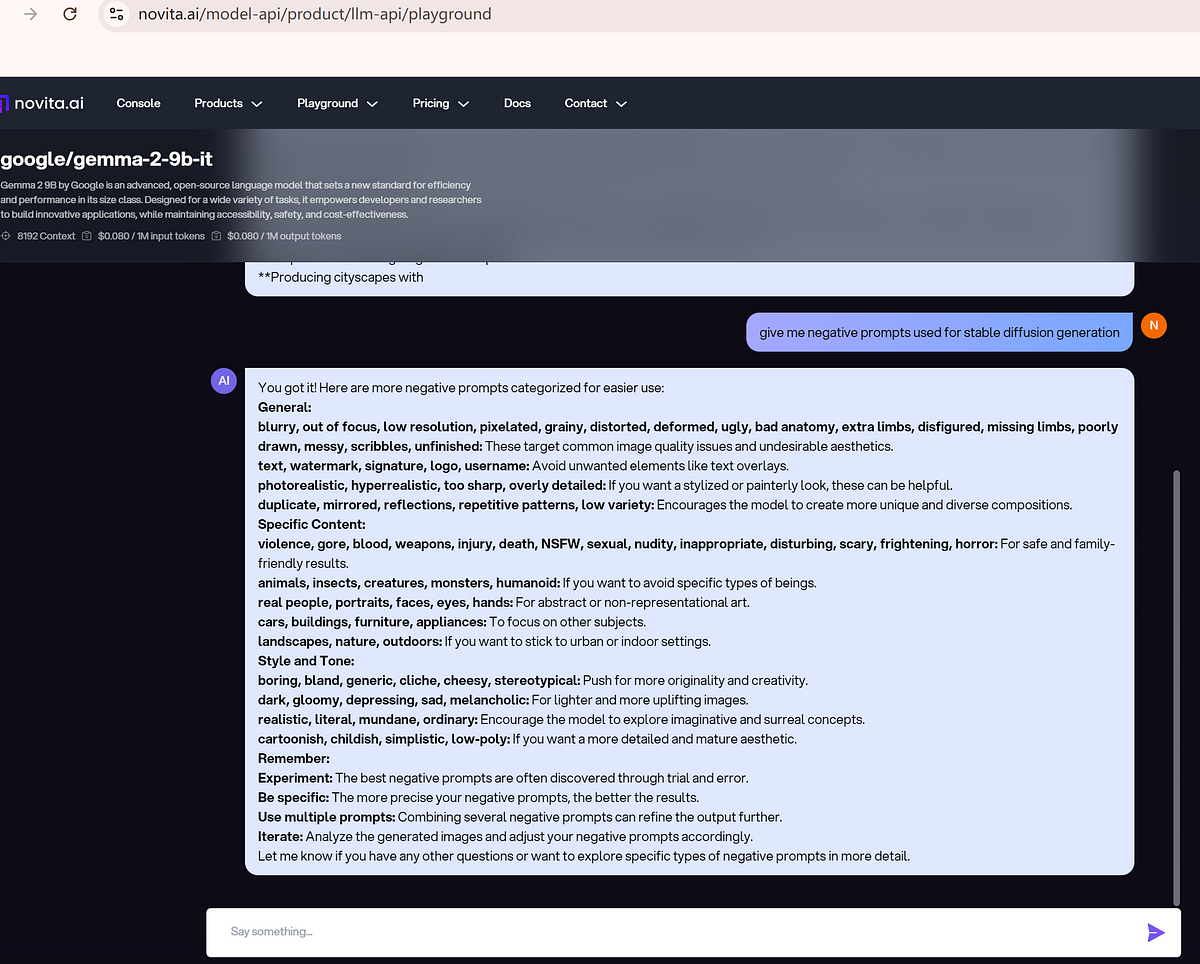
Step 3. Design the User Interface: Create an intuitive UI that allows users to input both positive and negative prompts easily.
Step 4. LLM Integration:
- Sign in to get an API key. Sign up/ log in at Novita AI. Then go to Novita AI LLM API key to obtain the key. Additionally, we provide new users with a voucher for some initial credit to sample our products!
- Use your key based on LLM API Instruction. For more info, you can go to LLM API Reference.
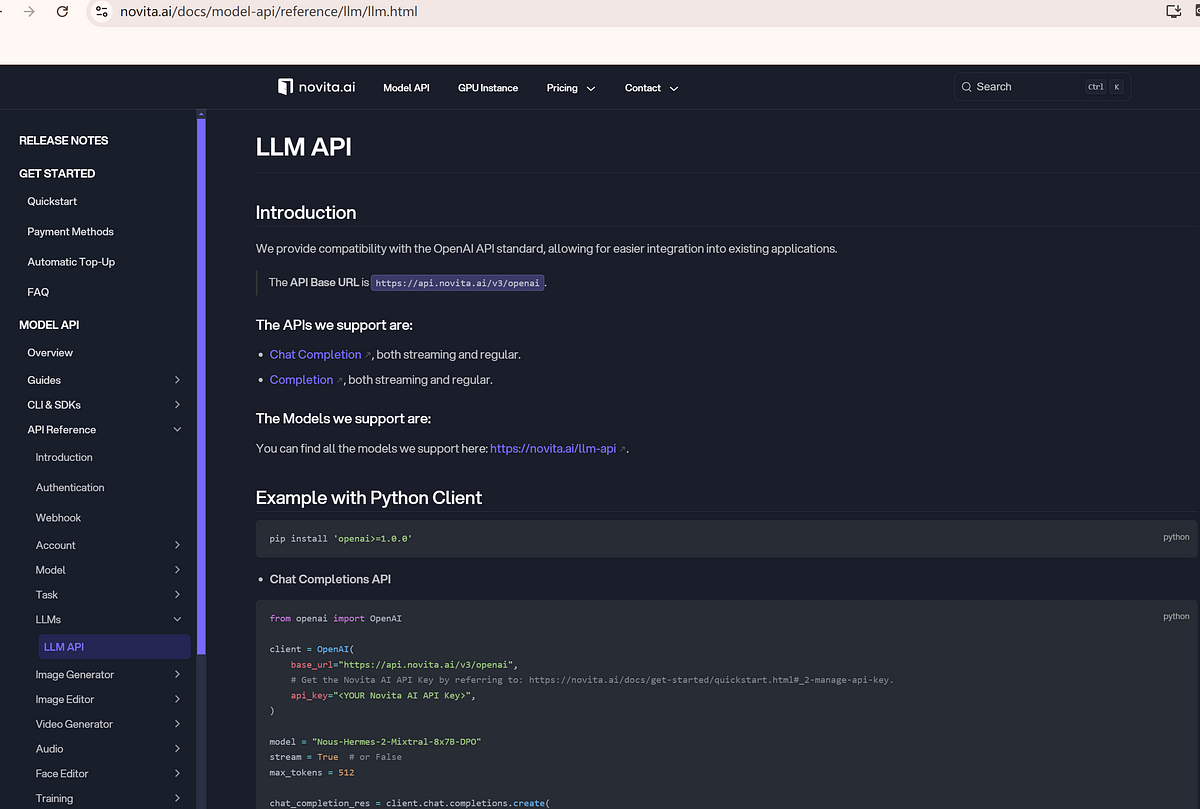
- Integrate the LLM to handle natural language inputs, enabling the tool to interpret and process negative prompts effectively.
Step 5. Develop the Negative Prompt Algorithm: Create an algorithm that processes negative prompts by identifying and excluding undesired elements in the generated output.
Step 6. Testing and Iteration: Conduct extensive testing to ensure the tool accurately excludes elements as specified by the negative prompts.
Step 7. Implement Feedback Mechanism: Allow users to provide feedback on the accuracy of the outputs, and use this data to improve the model’s performance.
Step 8. Optimize for Performance: Ensure the tool operates efficiently, especially when processing complex prompts, by optimizing the model’s computational performance.
Step 9. Deployment and Maintenance: Deploy the tool, and establish a maintenance plan for regular updates, bug fixes, and improvements based on user feedback.
Conclusion
Negative prompts significantly enhance AI-generated content by allowing users to exclude specific unwanted features, leading to higher quality and more relevant results. They provide precise control over artistic and content outcomes, making them valuable for artists, creators, and developers. Mastering their use, with support from platforms like Novita AI, is essential for achieving tailored and high-quality outputs in the evolving landscape of AI technology.
Frequently Asked Questions
What Are the Negative Prompts for Video?
Negative feedback typically includes undesirable features such as low resolution, errors, cropping, low quality level, and more.
Can Negative Prompts Be Used for All Types of Digital Creations?
In image generation, they help remove unwanted elements or styles like specific colors or objects. For text generation, negative prompts avoid certain themes or styles to align with expectations.
What Are Some Common Mistakes to Avoid When Using Negative Prompts?
Common errors are being too vague. An example is saying “bad anatomy” when you could be more specific, like “gross proportions” or “extra limbs.” Avoid excessive negative cues to ensure clear and concise results.
How Can Beginners Start Experimenting with Negative Prompts Effectively?
Beginners can begin by making a list of common negative prompts. Then, they can try changing the weights and mixing important terms. It’s better to focus on precision and relevance instead of just having a lot of options.
Novita AI is the All-in-one cloud platform that empowers your AI ambitions. Integrated APIs, serverless, GPU Instance — the cost-effective tools you need. Eliminate infrastructure, start free, and make your AI vision a reality.
Recommended Reading